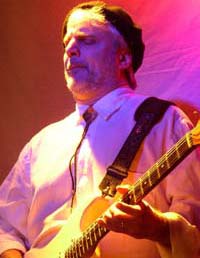Reducing guitar noise can be tricky, but it is easy to boost the guitar signal to improve the signal-to-noise ratio (SNR), and some ways are better than others…
Guitar Noise Manual by PedalSnake®
.
 Jody Page, PedalSnake’s inventor and lifelong pro guitarist, is an electrical engineer (a member of NASA’s Space Foundation Hall of Fame, no less) with special training in electrical noise. In the Guitar Noise Manual, Jody starts by breaking down guitar rig noise into 6 types:
Jody Page, PedalSnake’s inventor and lifelong pro guitarist, is an electrical engineer (a member of NASA’s Space Foundation Hall of Fame, no less) with special training in electrical noise. In the Guitar Noise Manual, Jody starts by breaking down guitar rig noise into 6 types:
1) BUZZ 2) HUM 3) HISS 4) DIGITAL NOISE (WHINE) 5) POWER SUPPLY NOISE 6) CABLE MICROPHONICS
For each noise, Jody explains its causes, then offers a targeted set of solutions. Also included are several helpful articles on general best-practices for noise reduction.
.
What’s the Deal With Signal-to-Noise Ratio?
All God’s Children Got Noise
There is no such thing as “zero noise” in any audio device. Hopefully we don’t hear it, because our audio signal is so much louder than the noise. This is what is important to achieve, a high signal-to-noise ratio (SNR).
If your guitar signal is 100 times greater than your noise level, you may be happy. But if your signal is only 2 times greater, you WILL NOT be happy.
 To achieve a higher SNR (aka a quieter rig), you can either reduce the noise, increase the signal, or both.
To achieve a higher SNR (aka a quieter rig), you can either reduce the noise, increase the signal, or both.
Even though the Guitar Noise Manual shows you how, reducing noise can be tricky. So it makes sense (for anyone and everyone, really) to boost their guitar signal as much they can without adversely affect their sound.
.
Signal Chain
Most electric guitar players now have a signal chain that includes the guitar, some effects pedals, and an amplifier. The pedals, as well as various gain, drive, and volume knobs on the amp, are called “gain stages”.
NOTE We will limit this discussion to a tube amp, since most players still prefer them. But really, the issues here apply to most any guitar amp.
>
When you boost any signal, you can’t help but also boost the noise that is part of that signal (there is always some). But the boost allows you to turn down all the subsequent gain stages, reducing the noise of the overall system.
In order to boost the most signal, and the least noise, we take the signal at its earliest point in the signal chain, its birthplace: The Guitar.
If you need to reduce the noise of the guitar signal, see Noisy Pickups.
.
So we do it like this:

Your guitar generally connects directly to the first preamp tube in your amp, with no volume knob between it and your guitar. Our goal is to drive this tube as hard as possible without adversely affecting your sound.
Here’s how:
.
Step by Step
1. Choose a boost pedal. While you can use any overdrive pedal, we prefer a clean boost, because:
* It is easy to find ones with very low noise and distortion.
* They boost with no audible distortion, which makes the process more effective. It also makes the process easier, because you can tell better what is happening downstream.
* Contrary to popular belief, good ones do not have to be costly. It requires very little circuitry and expertise to simply boost a signal without introducing noise or distortion.
.
NOTE: We just happen to use an old DOD FX1o Bi-FET Preamp pedal. It’s not expensive, and is super quiet, super clean, and has tones of gain (maybe 20 dB). But most any good clean boost will do.
.
2. Decide upon the least amount of distortion you will ever use (when the guitar is all the way up). In other words: What is the cleanest tone ever want to have? Some may want this totally clean, other may want varying amounts of distortion.
.
3. Plug your guitar into the boost pedal, and turn all the other pedals off.
.
4. Set all the gain stages of the amp to very low settings, so that no distortion will produced. If you can barely hear it, that is OK. Turn up the last gain knob in the amp’s signal chain, usually called “volume”, enough to hear what you are doing.
.
5. See how hard you can drive that first preamp tube without exceeding your cleanest tone. Use only the boost pedal.
.
6. Once you find that setting on the clean boost, readjust (with lower gain now) all pedal and amp gain controls to achieve the gain structure and tone you had before.
.
You should be able to tweak everything back to your previous tone, with a significant reduction in noise level. If not, play around with it for a while. You’ll get there.
Additional contributor
Jerry Miller, Miller Patent Services, Raleigh NC; electrical engineer, guitarist, amp builder.
.
